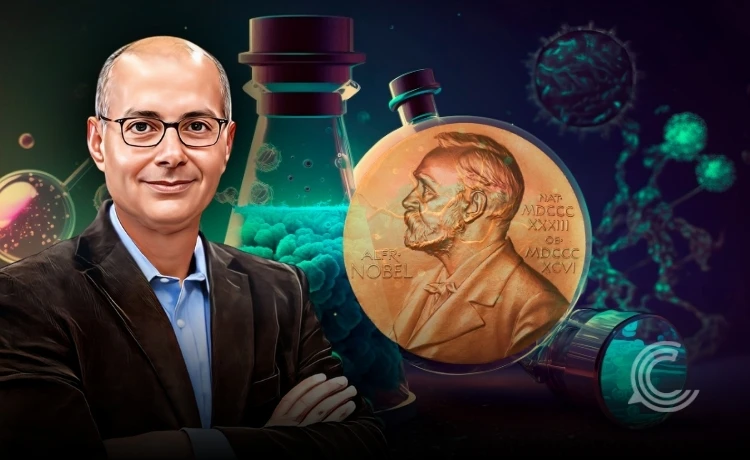Nobel Chemistry Prize 2025 Awarded for Groundbreaking Metal-Organic Frameworks

Key Highlights–
- Susumu Kitagawa, Richard Robson, and Omar Yaghi share the 2025 Nobel Chemistry Prize for developing metal-organic frameworks (MOFs).
- Their work enables new materials that can capture carbon, harvest water and store toxic gases.
- The discovery could reshape environmental science and clean energy research worldwide.
The Nobel Chemistry Prize 2025 has been awarded to three scientists – Susumu Kitagawa, Richard Robson, and Omar M. Yaghi, for their pioneering work on metal-organic frameworks (MOFs), advanced materials capable of storing gases, capturing carbon dioxide, and even harvesting water from desert air.
BREAKING NEWS
— The Nobel Prize (@NobelPrize) October 8, 2025
The Royal Swedish Academy of Sciences has decided to award the 2025 #NobelPrize in Chemistry to Susumu Kitagawa, Richard Robson and Omar M. Yaghi “for the development of metal–organic frameworks.” pic.twitter.com/IRrV57ObD6
Revolutionary Discovery Earns the Nobel Chemistry Prize
According to the official announcement by the Royal Swedish Academy of Sciences, the trio will be sharing 11 million Swedish crowns for their “development of metal-organic frameworks,” a discovery with sweeping implications for clean energy and environmental sustainability.
How the Nobel Chemistry Prize-Winning Work Began
The concept dates back to 1989, when Richard Robson experimented with positively charged copper ions and a four-armed organic molecule to form spacious crystals filled with microscopic cavities. As reported by BBC News, this breakthrough was like “a diamond filled with innumerable rooms.” However, Robson’s early structures were unstable and collapsed easily.
In the following decade, Susumu Kitagawa and Omar Yaghi built on this foundation independently. Kitagawa proved that gases could flow freely through the constructions and that the frameworks could be made flexible. Furthermore, Yaghi developed a stable MOF that could be customized for different applications through rational design. A key advancement recognized by the Nobel committee.
Transformative Potential of Metal-Organic Frameworks
The Nobel jury emphasized that MOFs represent a “new form of molecular architecture.” Each framework combines metal ions (acting as cornerstones) with organic molecules (linkers) to create crystal-like structures that contain pores large enough for gases and liquids to pass through.
As reported by Reuters, these porous materials could revolutionize industries, from reducing greenhouse emissions to developing efficient hydrogen storage systems. MOFs have already been used to capture carbon dioxide, store toxic gases, and filter pollutants from water. They also show promise in battery technology and drug delivery.
Heiner Linke, Chair of the Nobel Committee for Chemistry, stated that MOFs “bring previously unforeseen opportunities for custom-made materials with new functions,” highlighting their global scientific impact.
Who Are the Laureates?
Susumu Kitagawa, a professor at Kyoto University in Japan, earned his PhD in hydrocarbon chemistry and previously won the Humboldt Research Prize and the De Gennes Prize.
Richard Robson, originally from the UK and now at the University of Melbourne, studied at Oxford and laid the first foundation for MOF research in the late 1980s.
Omar Yaghi, born in Amman, Jordan, is a professor at the University of California, Berkeley. His work has helped advance “reticular chemistry”, the science of designing frameworks for molecular storage and reactions.
Broader Context of the 2025 Nobel Chemistry Prize
Last year’s Nobel Chemistry Prize honored scientists behind AI-driven protein structure research. This year’s award returns to a more traditional field of chemistry, one that nevertheless holds massive real-world applications. According to Nature News, researchers worldwide have created over 90,000 MOF variations to date, each offering unique capabilities in energy, sustainability, and environmental cleanup.
The Royal Swedish Academy described the discovery as “a milestone in molecular design,” adding that the development of MOFs may contribute to solving some of humanity’s greatest challenges, from clean drinking water to climate change mitigation.
Looking Ahead
As the Nobel Chemistry Prize 2025 shines a spotlight on this breakthrough, universities and start-ups are already racing to commercialize MOF-based technologies. The scientific community hopes that these materials could help create a more sustainable future by reducing carbon footprints and enhancing clean energy storage methods.
The Nobel Prize in Physics was announced yesterday, while the Nobel Prize in Literature will be revealed tomorrow, followed by the Peace Prize later this week.



